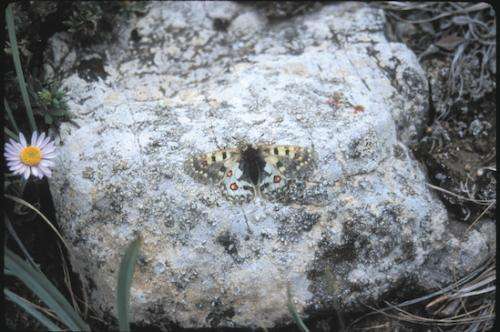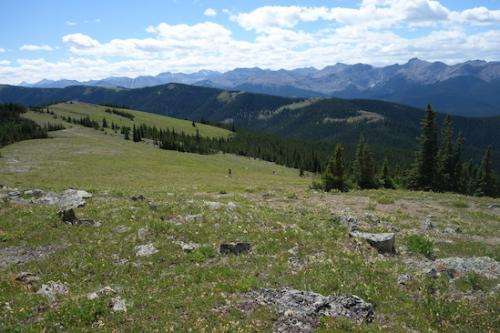Butterflies rely on connections amid changing climate

Butterflies in Canadian mountain meadows rebounded after a severe population crash. Why? It's all about connections, found a study by the University of California, Davis, in collaboration with Western University in Ontario, Canada, and other North American institutions.
The alpine butterfly lives in high-altitude meadows of the Rocky Mountains. The study focused on a network of them living along three ridge tops in Alberta, Canada. The butterflies' lives revolve around access to their host plants, the lanceleaf stonecrop and ledge stonecrop. Mother butterflies lay their eggs near these plants, where the larvae overwinter. A certain amount of snow cover is required to regulate the eggs' temperature before hatching.
But in the winter of 2003, the amount of snow needed didn't come. The population crashed, losing more than 60 percent of its members.
Here's where things could have gotten very bad for this population of alpine butterfly. But it didn't, at least not for the long term. Enough patches of butterfly activity remained that could easily connect with each other. This allowed the population to rebound with their genetic diversity mostly intact, according to the study published this week in the journal Proceedings of the Royal Society.
"The population crashed, but it was through their connectivity that they were able to maintain genetic diversity," said lead author Serena Caplins, a doctoral student of population biology at UC Davis.
Scientists from the University of Alberta and University of Cincinnati had been collecting data on this network of alpine butterflies since 1995. This gave the study's researchers an ideal opportunity to compare genetic differences in the butterflies before and after the 2003 population crash. Caplins and her colleagues found that patches with low connectivity lost more genetic diversity than those with high connectivity. In short, the easier it was for the butterflies to find each other, the more genetic diversity remained.

Yet forests responding to warming weather are encroaching on the butterflies' meadow habitat, making them more isolated from each other. For the butterflies, these growing, warming forests are akin to an interstate through a mountain—fragmenting their habitat and cutting them off from other alpine butterflies. If they continue to separate and there's another population crash, it could be harder for them to restore genetic diversity.
The study provides insight into the importance of providing connections—be they through greenbelts or greater habitat protection—so populations can rebound and maintain genetic diversity in the face of climate change and other stressors. Genetic diversity, in turn, can lead to healthier populations that are more prepared to weather environmental impacts.
"Overall this was positive," said Caplins of the results. "It suggests some of these populations may be more robust than we thought, but it is a warning that if things continue to get worse, and connectivity decreases, it could be a problem down the road."
Journal information: Proceedings of the Royal Society
Provided by UC Davis


















